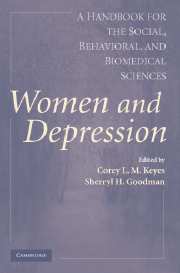Book contents
- Frontmatter
- Contents
- List of Contributors
- Foreword
- Preface
- PART I NOSOLOGY, MEASUREMENT, AND THE EPIDEMIOLOGY OF WOMEN AND DEPRESSION
- PART II BIOLOGICAL, DEVELOPMENTAL, AND AGING MODELS OF RISK
- PART III COGNITIVE, EMOTIONAL, AND INTERPERSONAL MODELS OF RISK
- 7 Cognition and Depression
- 8 Personality and Depression in Women
- 9 The Social Costs of Stress
- 10 Marriage and Depression
- 11 Depression in Women Who Are Mothers
- PART IV SOCIAL, POLITICAL, AND ECONOMIC MODELS OF RISK
- PART V SYSTEMS AND PROCESSES OF TREATMENT, PREVENTION, AND POLICY
- Author Index
- Subject Index
- References
7 - Cognition and Depression
Published online by Cambridge University Press: 05 June 2012
- Frontmatter
- Contents
- List of Contributors
- Foreword
- Preface
- PART I NOSOLOGY, MEASUREMENT, AND THE EPIDEMIOLOGY OF WOMEN AND DEPRESSION
- PART II BIOLOGICAL, DEVELOPMENTAL, AND AGING MODELS OF RISK
- PART III COGNITIVE, EMOTIONAL, AND INTERPERSONAL MODELS OF RISK
- 7 Cognition and Depression
- 8 Personality and Depression in Women
- 9 The Social Costs of Stress
- 10 Marriage and Depression
- 11 Depression in Women Who Are Mothers
- PART IV SOCIAL, POLITICAL, AND ECONOMIC MODELS OF RISK
- PART V SYSTEMS AND PROCESSES OF TREATMENT, PREVENTION, AND POLICY
- Author Index
- Subject Index
- References
Summary
Cognitive models of depression have been popular over the past four decades (Abramson et al., 2002). Do these cognitive models help to explain why women are more prone to depression than men (cf. Nolen-Hoeksema, 2002)? In this chapter, we will address this question, examining each of four broad categories of cognitive variables that have been proposed as predisposing factors for depression. The first of these is the self-concept or the characteristic ways that people think about themselves. The second is interpersonal orientation or the characteristic ways that people think about their relationships with others. The third is cognitive style or the characteristic ways that people think about the things that happen to them and about what the future is likely to bring. The fourth is coping style or the characteristic ways that people deal with the stressful things that happen to them or with their depressed feelings.
Unfortunately, most of the research on the relationship between cognition and depression is concurrent in nature. That is, the measures of the cognitive variables and depression variables were administered at the same time. This makes it impossible to discern the causal direction of any relationship that is found, because it is as easy to imagine that depression affects the way people think as it is to imagine that the way people think affects how depressed they are (and, indeed, there is evidence for effects in both directions).
- Type
- Chapter
- Information
- Women and DepressionA Handbook for the Social, Behavioral, and Biomedical Sciences, pp. 147 - 175Publisher: Cambridge University PressPrint publication year: 2006
References
- 6
- Cited by



